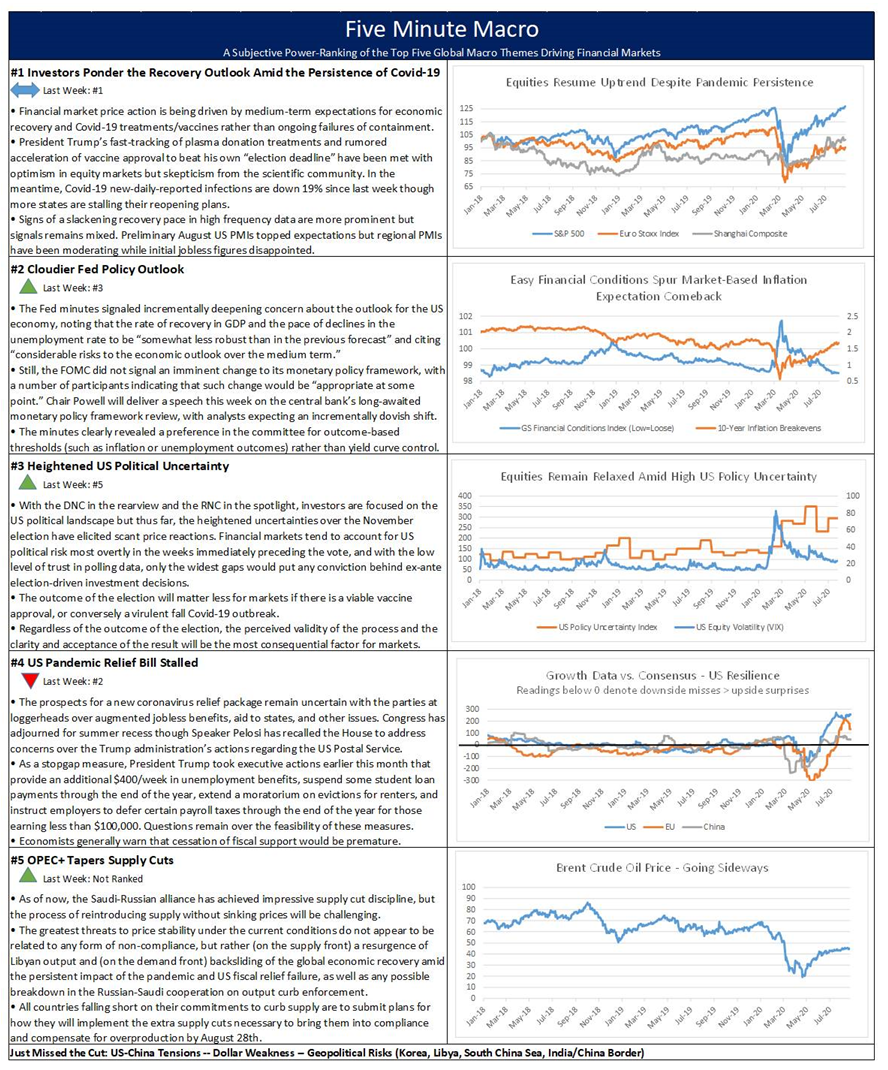Summary and Price Action Rundown
Global risk assets are mixed this morning as investors continue to digest the monetary policy shift announced by Fed Chair Powell yesterday. S&P 500 futures point to a 0.3% higher open after the index held gains of 0.2% in yesterday’s seesaw trading session, increasing its year-to-date gain to 7.9% and registering its fifth straight all-time high. Equities in the EU are muted, while Asian stocks were mixed overnight, with the Nikkei underperforming after the resignation of Prime Minister Abe (more below). The dollar is sinking to a new multi-year low, while longer-dated Treasury yields are steady after yesterday’s rise, with the 10-year yield hovering at its highest level since June at 0.75%. Brent crude is holding above $45 per barrel.
Fed Monetary Policy Shift Announcement Leaves Questions
Markets have exhibited somewhat mixed reactions after the unveiling of a moderately more dovish formulation for inflation targeting and added nuance to the Fed’s stance on full employment left a meaningful degree of ambiguity. In his virtual Jackson Hole conference speech yesterday morning, Fed Chair Powell unveiled a new framework of price stability for the central bank that will tolerate inflation “moderately” above its target so that it averages 2% over time, referencing core personal consumption expenditures prices (which excludes volatile components like energy and food prices). Although analysts note that this new strategy will to some degree restrain the practice the Fed has followed for more than three decades of pre-emptively lifting interest rates to head off higher inflation, the exact interplay between the new target and interest rate or asset purchase policy was left unclear. St. Louis Fed President Bullard suggested that 2.5% inflation would be an acceptable level of overshooting, though Powell warned that “excessive inflationary pressures” would elicit Fed tightening. Meanwhile, Powell also indicated that its full employment mandate would be viewed going forward with particular reference to the lower-income segment. The Fed also committed to reviewing this policy every five years. These alterations to the Fed’s stance highlight that interest rates and other policy settings will remain exceptionally accommodation for the foreseeable future, though markets had already been pricing in an extended period of zero interest rates based on prior Fed guidance. At the September meeting, analysts expect that the Fed may more directly link their policy outlook to these revised mandates, known as “enhanced guidance.” Dallas Fed President Kaplan, however, indicated that there would be “no formula” for hitting the inflation target and suggested in his remarks today that extraordinary Fed easing programs should “sunset.”
Prime Minister Abe Resigns Due to Health
Japan’s longest serving Prime Minister will stay in office until a successor is determined by his party, but his impending departure weighed on Japanese equities and lifted the yen. The Nikkei underperformed regional peers overnight, closing 1.4% lower after initially falling over 3% on headlines regarding the upcoming move by Prime Minister Abe. Meanwhile, the yen, which tends to appreciate in times of market turmoil, is trading 1.2% higher versus the dollar. This news follows months of building concerns over Abe’s health, as he suffers a chronic digestive condition that had forced him to resign the premiership once already in 2007. As the architect of so-called “Abenomics,” an expressly reflationary combination of fiscal and monetary stimulus coupled with a reform program, analysts note some uncertainty over the continuation of his eponymous policy prescription, though reports today indicated that the Bank of Japan would persist with its current ultra-accommodative monetary policy program and Abe’s successor is expected to make few alterations to his blueprint. Nevertheless, Abe’s nearly 8-year tenure represented political stability and policy continuity that had been lacking after Prime Minister Koizumi ceded power in 2006, after which there were a revolving door of six premiers over six years, the first of which was Abe in his first truncated term. Abe also enjoyed a relatively stable relationship with President Trump, with Japan avoiding much of the trade policy friction and currency drama that has been leveled at other US trading partners. No timeline for choosing his successor has been announced and the next general election is not due until October 2021.
Additional Themes
Stalemate Continues of US Pandemic Stimulus – House Speaker Pelosi yesterday indicated that her call with White House Chief of Staff Meadows, which was their first contact in nearly three weeks, yielded no progress toward agreement on the latest pandemic stimulus bill. For context, this fiscal relief package has been in limbo after talks broke down earlier this month with the White House and House Democrats roughly $1 trillion apart, with no consensus on contentious issues like aid to states, the magnitude of unemployment benefits, and pandemic liability limitations for employers.
US Politics in Focus – Last evening on the closing night of the Republican National Convention, President Trump officially accepted his party’s nomination, touting his economic program in his acceptance speech and casting Joe Biden as a “Trojan horse for socialism.” US equity volatility futures and certain rates and currency derivatives convey a considerable degree of investor concern over potential turbulence surrounding the election date

